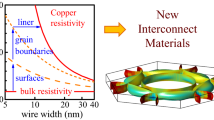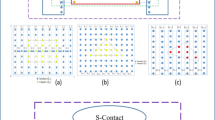Abstract
This paper explores the influence of temperature on the scattering mechanism of multilayer graphene nanoribbon (MLGNR). A thermally aware electrical ESC model along with mathematical computations is presented for evaluating the parasitic and reports the performance analysis dependent on temperature of the MLGNR at global interconnect length for 16 nm, 22 nm, and 32 nm nodes of technology in terms of power dissipation, delay, and power delay product (PDP). It was examined that with rising temperature, there is a strident decrease in the mean free path of GNR interconnect, which further influence its own resistance at variable global lengths (500‒2000 μm) for all three technology nodes. The simulation program with integrated circuit (SPICE) emphasis simulation tool is used to estimate and compare the performance of MLGNR in terms of power dissipation, signal delay and PDP for three different nodes of technology. It is revealed from the outcomes that the propagation delay and PDP increase at long interconnects (2000 μm) over a temperature range of 200 to 500 K for deep submicron technology nodes (16, 22, and 32 nm). Further, based on ITRS 2013, the analytical and simulated results are obtained at global interconnect length (2000 μm) for 16 nm technology node in the 200–500 K temperature range of MLGNR. The simulation and analytical results show that the outcomes of the two models are very similar. The models' trends show an increase in delay with increasing temperature levels (200‒500 K) 16 nm technology node.










Similar content being viewed by others
Data availability
Data sharing not applicable to this article as no datasets were generated or analyzed during the current study.
References
Meindl, J. D. (2003). Interconnect opportunities for gigascale integration. IEEE Micro, 23(3), 28–35. https://doi.org/10.1109/MM.2003.1209464
Sarto, M. S., Tamburrano, A., & D’Amore, M. (2008). New electron-waveguide-based modeling for carbon nanotube interconnects. IEEE Transactions on Nanotechnology, 8(2), 214–225. https://doi.org/10.1109/TNANO.2008.2010253
Pop, E., Mann, D., Wang, Q., Goodson, K., & Dai, H. (2006). Thermal conductance of an individual single-wall carbon nanotube above room temperature. Nano letters, 6(1), 96–100. https://doi.org/10.1021/nl052145f
Fang, Y., Zhao, W. S., Wang, X., Jiang, F., & Yin, W. Y. (2012, May). Circuit modelling of multilayer graphene nanoribbon (MLGNR) interconnects. In 2012 Asia-Pacific symposium on electromagnetic compatibility (pp. 625‒628). IEEE. https://doi.org/10.1109/APEMC.2012.6237942.
Hosseini, A., & Shabro, V. (2010). Thermally-aware modeling and performance evaluation for single-walled carbon nanotube-based interconnects for future high performance integrated circuits. Microelectronic Engineering, 87(10), 1955–1962. https://doi.org/10.1016/j.mee.2009.12.008
Li, B., Sullivan, T. D., Lee, T. C., & Badami, D. (2004). Reliability challenges for copper interconnects. Microelectronics Reliability, 44(3), 365–380. https://doi.org/10.1016/j.microrel.2003.11.004
Li, H., Xu, C., & Banerjee, K. (2010). Carbon nanomaterials: The ideal interconnect technology for next-generation ICs. IEEE Design & Test of Computers, 27(4), 20–31. https://doi.org/10.1109/MDT.2010.55
Balandin, A. A., Ghosh, S., Bao, W., Calizo, I., Teweldebrhan, D., Miao, F., & Lau, C. N. (2008). Superior thermal conductivity of single-layer graphene. Nano Letters, 8(3), 902–907. https://doi.org/10.1021/nl0731872
Naeemi, A., & Meindl, J. D. (2007). Conductance modeling for graphene nanoribbon (GNR) interconnects. IEEE Electron Device Letters, 28(5), 428–431. https://doi.org/10.1109/LED.2007.895452
Li, H., Xu, C., Srivastava, N., & Banerjee, K. (2009). Carbon nanomaterials for next-generation interconnects and passives: Physics, status, and prospects. IEEE Transactions on Electron Devices, 56(9), 1799–1821. https://doi.org/10.1109/TED.2009.2026524
Sharma, H., & Sandha, K. S. (2018). Multilayer graphene nanoribbon (MLGNR) as VLSI interconnect material at nano-scaled technology nodes. Transactions on Electrical and Electronic Materials, 19(6), 456–461. https://doi.org/10.1007/s42341-018-0070-4
Cavin, R. K., Zhirnov, V. V., Herr, D. J. C., Avila, A., & Hutchby, J. (2006). Research directions and challenges in nanoelectronics. Journal of Nanoparticle Research, 8(6), 841–858. https://doi.org/10.1007/s11051-006-9123-4
Sharma, H., & Sandha, K. S. (2020). Impact of intercalation doping on the conductivity of multi-layer graphene nanoribbon (MLGNR) in on-chip interconnects. Journal of Circuits, Systems and Computers, 29(12), 2050185. https://doi.org/10.1142/S0218126620501856
Kumar, V. R., Majumder, M. K., Kukkam, N. R., & Kaushik, B. K. (2015). Time and frequency domain analysis of MLGNR interconnects. IEEE Transactions on Nanotechnology, 14(3), 484–492. https://doi.org/10.1109/TNANO.2015.2408353
Han, M. Y., Özyilmaz, B., Zhang, Y., & Kim, P. (2007). Energy band-gap engineering of graphene nanoribbons. Physical Review Letters, 98(20), 206805. https://doi.org/10.1103/PhysRevLett.98.206805
Gunlycke, D., Lawler, H. M., & White, C. T. (2007). Room-temperature ballistic transport in narrow graphene strips. Physical Review B, 75(8), 085418. https://doi.org/10.1103/PhysRevB.75.085418
Naeemi, A., & Meindl, J. D. (2009). Compact physics-based circuit models for graphene nanoribbon interconnects. IEEE Transactions on Electron Devices, 56(9), 1822–1833. https://doi.org/10.1109/TED.2009.2026122
Berger, C., Song, Z., Li, X., Wu, X., Brown, N., Naud, C., ...& de Heer, W. A. (2006). Electronic confinement and coherence in patterned epitaxial grapheme. Science, 312(5777), 1191–1196. https://doi.org/10.1126/science.11259
Perebeinos, V., & Avouris, P. (2010). Inelastic scattering and current saturation in graphene. Physical Review B, 81(19), 195442. https://doi.org/10.1103/PhysRevB.81.195442
Xu, C., Li, H., & Banerjee, K. (2009). Modeling, analysis, and design of graphene nano-ribbon interconnects. IEEE Transactions on Electron Devices, 56(8), 1567–1578. https://doi.org/10.1109/TED.2009.2024254
Sharma, H., & Sandha, K. S. (2020). Investigation on the combined effects of variable Fermi energies and temperatures on the performance of multilayer graphene nanoribbon as interconnects. Analog Integrated Circuits and Signal Processing, 104, 157–168. https://doi.org/10.1007/s10470-020-01681-2
Cui, J. P., Zhao, W. S., Yin, W. Y., & Hu, J. (2011). Signal transmission analysis of multilayer graphene nano-ribbon (MLGNR) interconnects. IEEE Transactions on Electromagnetic Compatibility, 54(1), 126–132. https://doi.org/10.1109/TEMC.2011.2172947
International Technology Roadmap for Semiconductors, 2013 Edition, http://public.itrs.net. Accessed 01 September, 2022
Predictive Technology Models. [Online]. http://ptm.asu.edu
Nishad, A. K., & Sharma, R. (2013). Analytical time-domain models for performance optimization of multilayer GNR interconnects. IEEE Journal of Selected Topics in Quantum Electronics, 20(1), 17–24. https://doi.org/10.1109/JSTQE.2013.2272458
Kumar, V., & Naeemi, A. (2012). Analytical models for the frequency response of multi-layer graphene nanoribbon interconnects. In 2012 IEEE international symposium on electromagnetic compatibility (pp. 440‒445). IEEE. https://doi.org/10.1109/ISEMC.2012.6351837.
Kumar, V. R., Majumder, M. K., Alam, A., Kukkam, N. R., & Kaushik, B. K. (2015). Stability and delay analysis of multi-layered GNR and multi-walled CNT interconnects. Journal of Computational Electronics, 14, 611–618. https://doi.org/10.1007/s10825-015-0691-3
Majumder, M. K., Kukkam, N. R., & Kaushik, B. K. (2014). Frequency response and bandwidth analysis of multi-layer graphene nanoribbon and multi-walled carbon nanotube interconnects. Micro & Nano Letters, 9(9), 557–560. https://doi.org/10.1049/mnl.2013.0742
Kumar, V. R., Kaushik, B. K., & Patnaik, A. (2015). Crosstalk noise modeling of multiwall carbon nanotube (MWCNT) interconnects using finite-difference time-domain (FDTD) technique. Microelectronics Reliability, 55(1), 155–163. https://doi.org/10.1016/j.microrel.2014.09.001
Liang, F., Wang, G., & Ding, W. (2011). Estimation of time delay and repeater insertion in multiwall carbon nanotube interconnects. IEEE Transactions on Electron Devices, 58(8), 2712–2720. https://doi.org/10.1109/TED.2011.2154334
Author information
Authors and Affiliations
Contributions
Section 1 and 2 is the collaborative work of both the authors. Section 3 and 4 are written by 1st and 2nd author respectively Figures are prepared by author 1. All authors reviewed the manuscript
Corresponding author
Ethics declarations
Conflict of interest
The authors declare no conflict of interest.
Additional information
Publisher's Note
Springer Nature remains neutral with regard to jurisdictional claims in published maps and institutional affiliations.
Rights and permissions
Springer Nature or its licensor (e.g. a society or other partner) holds exclusive rights to this article under a publishing agreement with the author(s) or other rightsholder(s); author self-archiving of the accepted manuscript version of this article is solely governed by the terms of such publishing agreement and applicable law.
About this article
Cite this article
Sharma, H., Sandha, K.S. Thermally-aware circuit model and performance analysis of MLGNR for nano-interconnect application. Analog Integr Circ Sig Process (2024). https://doi.org/10.1007/s10470-024-02254-3
Received:
Revised:
Accepted:
Published:
DOI: https://doi.org/10.1007/s10470-024-02254-3




